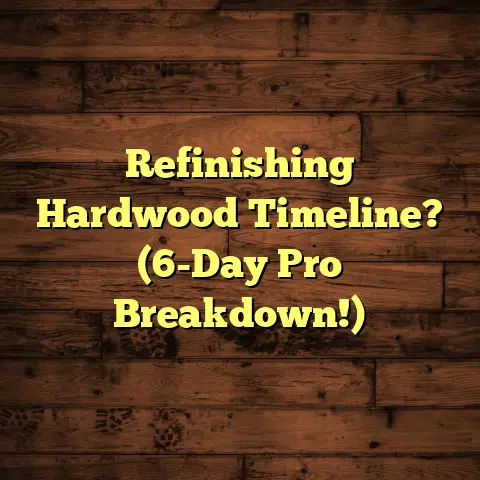Hardwood Floor Direction Ideas (10 Layout Fails!)
10 Layout Fails You Should Avoid
I’m Mike, your friendly neighborhood flooring contractor. I’ve spent years knee-deep in sawdust, transforming houses into homes with beautiful hardwood floors.And let me tell you, there’s nothing quite like the warmth and elegance that hardwood brings to a space. It’s durable, easy to clean (most of the time!), and its timeless aesthetic works with just about any interior style you can imagine.
But here’s the thing: even the most gorgeous hardwood can look… well, wrong if it’s not installed properly. And a big part of that “properly” is the layout direction.
Think of it this way: the way you lay your hardwood planks can dramatically impact how big your room feels, how the light bounces around, and even the overall flow of your home. Get it right, and you’ve got a stunning space. Get it wrong, and… oof.
That’s why I’m here today. I’m going to walk you through 10 common hardwood layout fails that I’ve seen over the years. Trust me, learning from these mistakes can save you a lot of headaches (and money!) down the road.
So, grab a cup of coffee (or a beer, no judgment!), and let’s dive in!
Section 1: Understanding Hardwood
Floor Direction
Okay, so what exactly is hardwood floor direction?
Simply put, it’s the way the planks are oriented when they’re installed. Are they running lengthwise down the room? Across the width? Maybe at a diagonal? That’s the direction.
And why does it matter? Well, for starters, it can dramatically affect the appearance of your room. Think of it like this:
-
Elongation: Running planks lengthwise can make a room feel longer and more spacious.
-
Light Reflection: The direction can influence how light bounces off the wood, affecting the overall brightness and ambiance.
-
Visual Flow: A consistent direction can create a sense of flow and continuity throughout your home.
As a general rule of thumb, I usually recommend laying wood floors parallel to the longest wall or the main source of natural light. This tends to create the most visually pleasing and balanced look.
But there are other layout styles to consider too:
-
Straight: The most common and straightforward (pun intended!) style, where planks are laid in parallel rows.
-
Diagonal: Adds a touch of sophistication and can make a small room feel larger.
-
Herringbone: A classic and elegant pattern that creates a zigzag effect.
Each of these styles has its own aesthetic impact, so it’s important to choose one that complements your space and your personal taste.
Now, let’s get to the juicy part: the fails!
Section 2: Common Layout Fails
Alright, buckle up, because we’re about to dive into the 10 most common hardwood layout fails I’ve encountered in my years as a flooring contractor. I will also be providing visuals or diagrams to illustrate the points.
1. Fail #1: Ignoring the Room’s
Natural Light Source
This is a big one. Natural light can make or break a room, and the way you lay your hardwood can either enhance it or completely sabotage it.
Imagine this: you’ve got a beautiful picture window that floods your living room with sunlight. Now, imagine laying your hardwood planks perpendicular to that window.
What happens?
The light hits the short ends of the planks, creating a choppy, disjointed look. It can make the room feel smaller and less inviting.
Better Alternatives:
-
Parallel to the light: Laying the planks parallel to the window creates a smooth, continuous surface that reflects the light beautifully.
-
Sidelight Consideration: If you’re working with sidelight, consider how it changes throughout the day.
2. Fail #2: Misalignment with
Architectural Features
This is another one that can drive a detail-oriented person absolutely crazy. We’re talking about doors, windows, fireplaces – all those architectural elements that define a room.
Imagine laying your hardwood and then realizing that the planks are completely out of alignment with the doorway.
It just looks… off.
It’s like wearing socks with sandals. It might be comfortable, but it’s definitely not a good look.
Proper Alignment Strategies:
-
Start at the focal point: Begin your layout at the most prominent architectural feature, like a fireplace or a large window.
-
Use a reference line: Snap a chalk line to ensure that your first row of planks is perfectly straight and aligned with the feature.
-
Transitions are key: Pay special attention to transitions between rooms, ensuring that the plank direction flows seamlessly.
3. Fail #3: Poor Transitions
Between Rooms
Speaking of transitions, this is where a lot of homeowners stumble.
Think about it: you’re walking from one room to another, and suddenly the hardwood planks change direction.
It’s jarring!
It disrupts the flow of the house and can make the space feel disjointed.
Suggestions for Seamless Transitions:
-
Maintain consistent direction: The easiest way to avoid this is to maintain the same plank direction throughout the house.
-
Use transition strips: If you absolutely have to change direction, use a transition strip to create a clean and intentional break.
-
Consider a threshold: A threshold can also be used to visually separate two rooms with different flooring directions.
4. Fail #4: Using Inappropriate
Patterns for Small Spaces
Okay, let’s talk about patterns. Herringbone, chevron, parquet – they can all be stunning, but they’re not always the right choice for every space.
In a small room, a complex pattern can feel overwhelming and claustrophobic. It can make the room feel even smaller than it actually is.
Simpler Layouts that Enhance Space Perception:
-
Straight lay: A simple, straight lay is almost always the best choice for a small room.
-
Diagonal lay: A diagonal lay can also work well, as it visually expands the space.
-
Wider planks: Using wider planks can also make a small room feel more open.
5. Fail #5: Laying Planks Across
Joists
This is where things get a little technical, but it’s important to understand the structural implications of your flooring layout.
In most homes, the floor joists run in one direction. And if you lay your hardwood planks perpendicular to those joists, you’re essentially creating a weak spot in your floor.
Over time, this can lead to squeaks, bouncing, and even structural damage.
Recommendations for Proper Installation Practices:
-
Lay planks perpendicular to the joists: This provides the best structural support.
-
Add additional support: If you have to lay planks parallel to the joists, you may need to add additional support, such as bridging or blocking.
-
Consult a professional: If you’re not sure about the joist direction in your home, consult a qualified contractor.
6. Fail #6: Neglecting Furniture
Placement
Your furniture is a big part of your room’s overall design, and it’s important to consider how it will interact with your flooring.
Imagine laying your hardwood and then realizing that your furniture is completely obscuring the beautiful pattern you’ve created.
Or, even worse, imagine that your furniture is highlighting a flaw in your flooring layout.
Tips for Coordinating Flooring with Furniture Arrangements:
-
Consider the scale of your furniture: Larger pieces of furniture can handle more complex flooring patterns.
-
Use rugs to define spaces: Rugs can be used to visually separate different areas of a room and to highlight specific features of your flooring.
-
Don’t be afraid to experiment: Try different furniture arrangements to see what works best with your flooring.
7. Fail #7: Inconsistent Direction
in Open Concept Spaces
Open concept living is all the rage these days, but it can also present some challenges when it comes to flooring.
One of the biggest challenges is maintaining a consistent look across large, open spaces. If you start changing plank direction willy-nilly, it can disrupt the flow and make the space feel chaotic.
Strategies for a Cohesive Look Across Large Areas:
-
Stick to one direction: The easiest way to create a cohesive look is to maintain the same plank direction throughout the entire open concept space.
-
Use subtle transitions: If you have to change direction, do it subtly, using transition strips or thresholds.
-
Create visual zones: Use rugs or furniture to create visual zones within the open concept space.
8. Fail #8: Overlooking the Effect
of Color and Grain
The color and grain pattern of your hardwood can also influence how it looks when laid in certain directions.
For example, if you have a wood with a strong grain pattern, laying it in a diagonal direction can create a very busy and distracting look.
Similarly, a dark wood can make a small room feel even smaller if it’s not laid in the right direction.
Insights on Selecting Colors that Align with Layout Direction:
-
Lighter colors make rooms feel larger: If you’re working with a small room, opt for a lighter wood color.
-
Darker colors add warmth and intimacy: If you’re working with a large room, a darker wood color can help to create a more intimate atmosphere.
-
Consider the grain pattern: Choose a grain pattern that complements the overall style of your home.
9. Fail #9: Failing to Consider
Future Renovations
This is something that a lot of homeowners don’t think about, but it’s important to consider how your current flooring direction might affect future renovations.
For example, if you’re planning to add an addition to your home in the future, you’ll want to make sure that the flooring in the addition will seamlessly integrate with the existing flooring.
Encouraging Planning for Potential Changes Down the Line:
-
Think about future layouts: Consider how your furniture arrangement might change in the future.
-
Choose a versatile flooring style: Opt for a flooring style that will work with a variety of different design schemes.
-
Keep extra planks on hand: This will make it easier to match the flooring if you need to make repairs or additions in the future.
10. Fail #10: DIY Installation
Mistakes
Finally, let’s talk about DIY installation. I’m all for saving money, but hardwood flooring is one area where it’s often best to leave it to the pros.
DIY installations are rife with potential pitfalls, from improper measurements to alignment errors. And trust me, a poorly installed hardwood floor is much more expensive to fix than a professionally installed one.
Tips for Avoiding These Pitfalls, Including the Benefits of Hiring Professionals:
-
Measure twice, cut once: This old adage is especially true when it comes to hardwood flooring.
-
Use the right tools: Make sure you have all the necessary tools before you start the installation.
-
Don’t be afraid to ask for help: If you’re unsure about any aspect of the installation, don’t hesitate to call in a professional.
Conclusion
So, there you have it: 10 hardwood flooring layout fails to avoid. I know it seems like a lot to consider, but trust me, taking the time to plan your flooring layout carefully will pay off in the long run.
By avoiding these common mistakes, you can create a space that is both visually appealing and functional, enhancing the overall value and enjoyment of your home.
Remember, your hardwood floors are an investment, so treat them with the respect they deserve. And if you’re ever in doubt, don’t hesitate to call in a professional.
Happy flooring!





